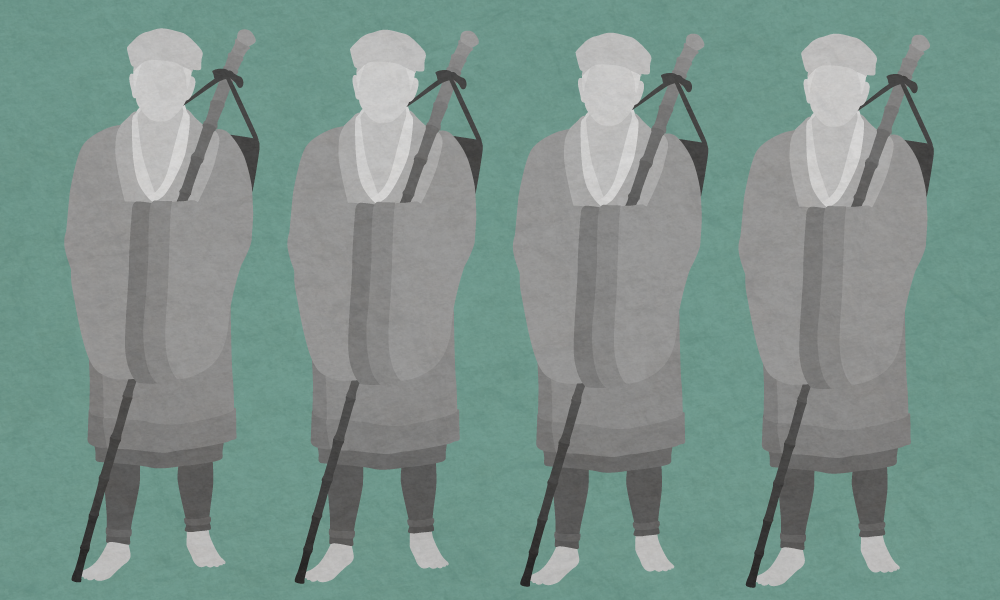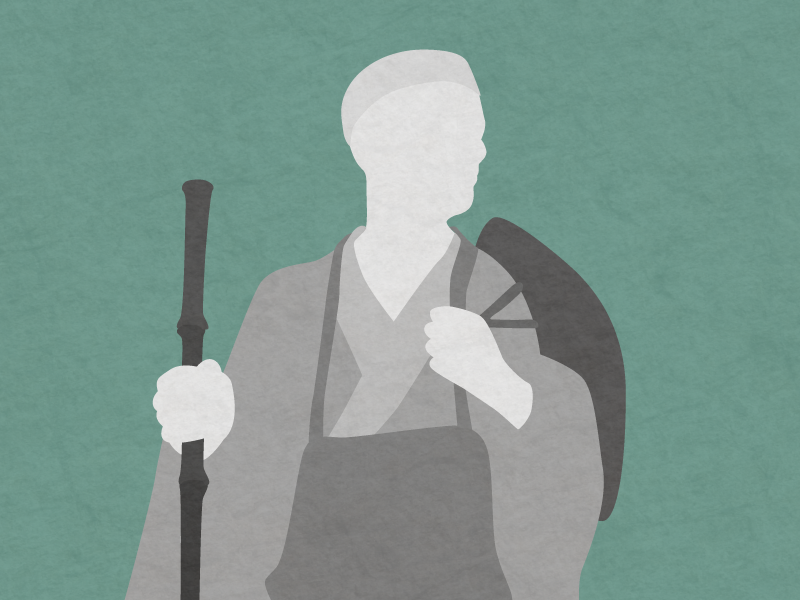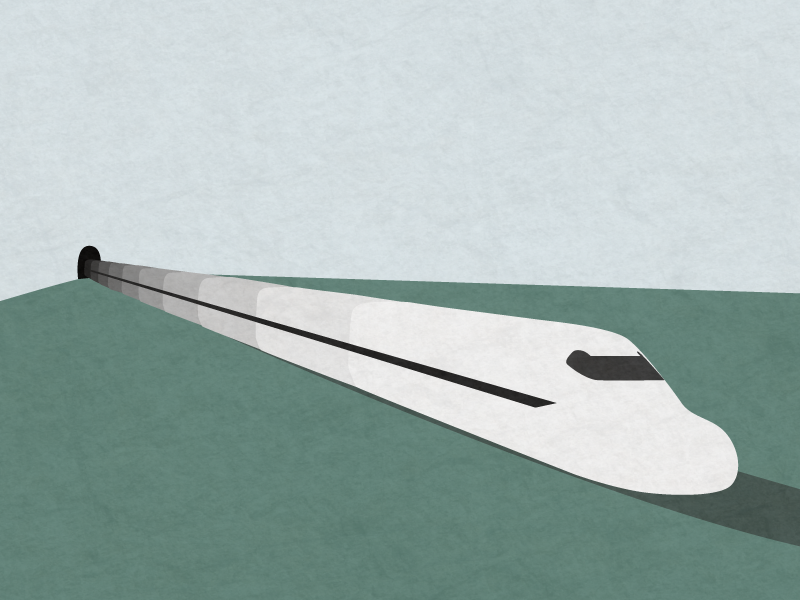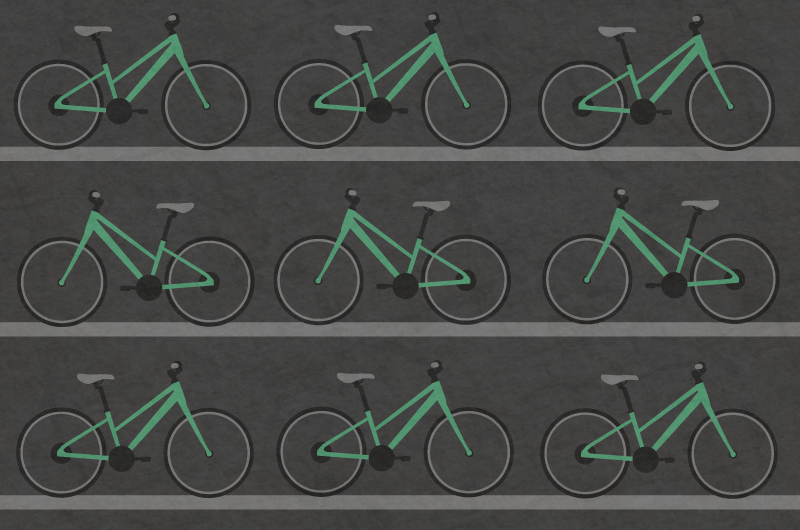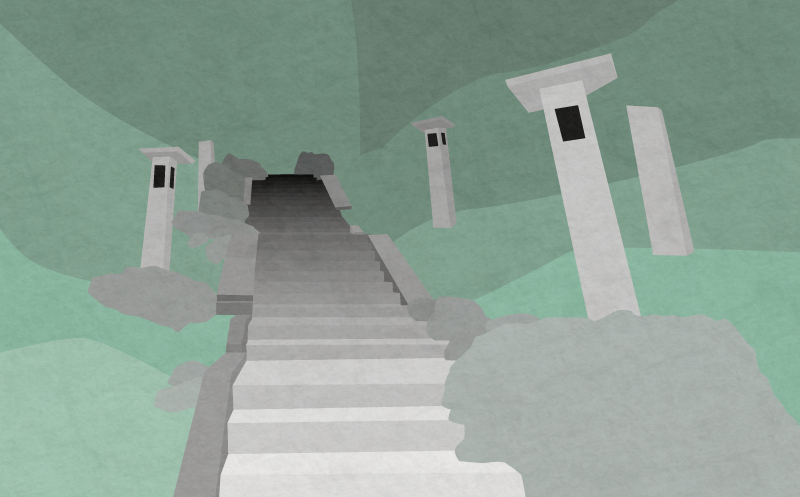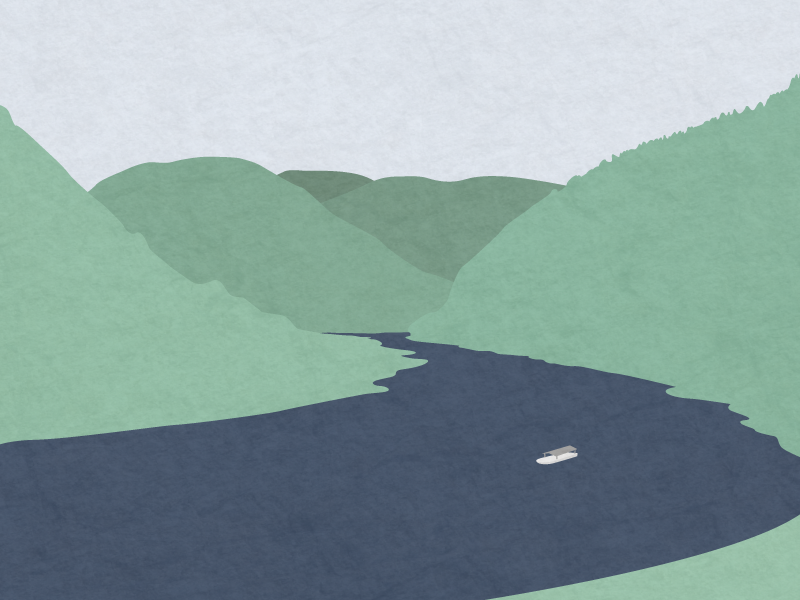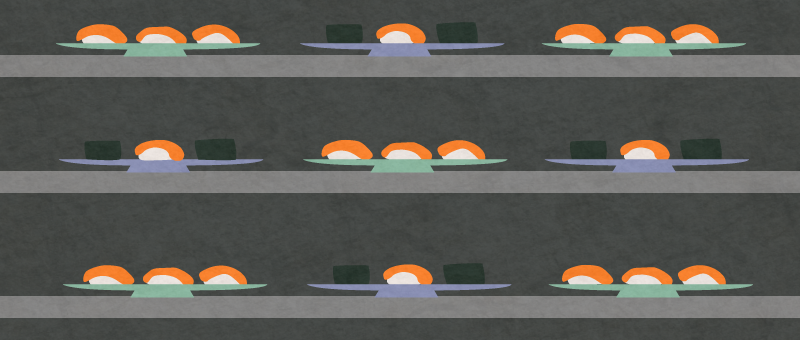Although I grew up in Kansas, I’ve had a long interest in Japan with many points of contact along the way. A Japanese history course at the University of Kansas, a two-year Army tour in Okinawa, visits to Hiroshima and Nagasaki, a climb up Mt. Fuji, a sabbatical in Japan studying the Japanese Constitution, and about 20 trips to Japan visiting my wife, Miyo, and taking trips with her in her home country. But never had we gone to the far or “deep north” of the largest of the four main Japanese islands, Honshu.
Several years ago, I happened upon the excellent travel book by Lesley Downer, On the Narrow Road to the Deep North: Journey into a Lost Japan. 300 years after haiku master, Basho’s, trip to the “deep north,” Downer tried to follow in his footsteps, walking and hitchhiking, eating flowers and sautéed grasshoppers, amongst other things. Before reading her fascinating book, I had not known of Basho. Matsuo Munefusa (1644 – 1694) was the most famous poet of the Edo period (1615 – 1868) in Japan. His disciples built him a rustic hut and planted a banana plant (basho in Japanese) in his yard. Basho’s disciples called his house the basho house and Basho liked the term so much he changed his last name. Since then, he has been known as Matsuo Basho and his poetry is internationally renowned.
In Japan, many of his poems are reproduced on monuments and statues of him. He made a living as a teacher, but he renounced the social life of the literary circles and wandered throughout the country to gain inspiration for his poems. His poems were influenced by his firsthand experience of the world around him, which he captures simply in his haiku. Despite his success, he grew dissatisfied, lonely and sought refuge in travel. He traveled alone, off the beaten path. At first, Basho expected to die in the middle of nowhere or be killed. As he traveled more, however, he gained confidence and he became comfortable on the road. He grew to enjoy the changing scenery and the seasons. Basho attempted to compress the meaning of the world into the simple pattern of his poetry, disclosing hidden hopes in small things.
Basho set off on a series of travels — the longest lasting two-and-a-half years — designed to strip away the trappings of the material world and bring spiritual enlightenment. In his poems, he described the natural world with simplicity and delicacy. He wrote of the seasons changing, the smell of the rain, the brightness of the moon, and the beauty of the waterfall:
It was with awe
that I beheld
fresh leaves, green leaves
bright in the sun.
When Basho traveled, he relied entirely on the hospitality of Buddhist temples and fellow poets. From 1666 – 1671, he spent much of his time at a temple in Kyoto and then moved to Edo (Tokyo) for the next few years.
My souvenir from Edo
is the refreshingly cold wind
of Mount Fuji
I brought home on my fan.
In 1684, he started on the first of his major journeys in Japan. Travels in his day were made under very precarious conditions and few people thought of taking the road for pleasure. One of his journeys he titled “The Records of a Weather-Exposed Skeleton.”
Breaking the silence
of an ancient pond,
a frog jumped into water
a deep resonance.
In 1689, Basho began his longest trip on “the narrow road to the deep north” — deep into the central and northern part of Honshu. The north of Honshu was largely unexplored territory and it represented all the mystery in the universe. He wrote picturesque descriptions of what he saw, and he wrote haiku as the spirit moved him.
The passing spring,
birds mourn
fishes weep
with tearful eyes.Silent a while in a cave
I watched a waterfall
for the first of
the summer observances.Even the woodpeckers
have left it untouched
this tiny cottage
in a summer grove.
On the first day of May in 1689, Basho stopped overnight at Iizuka. He wrote:
I had a bath in a hot spring before I took shelter at an inn. It was a filthy place with rough straw mats spread out on an earth floor. A storm came upon us towards midnight, and between the noise of thunder and leaking rain and the raids of mosquitoes and fleas, I could not get a wink of sleep.
My wife and I decided to follow his route by trains for the most part. I love to ride trains. I have ridden most of the long-distance trains in the U.S., some several times. We got a seven-day Japan Rail Pass and followed Basho’s route as much as possible, riding all kinds of trains: the famous Shinkansen (the Bullet Trains) which go close to 200 mph and little two-car trains which go a little more than 30 mph. We also took two boat tours in our attempt to follow Basho’s footsteps — but without the hardship.
On April 28th, we left Kyoto Station bound for Sendai City where Basho spent about a week. We took the Hikari (“lightening”) train to Tokyo (227 miles northeast of Kyoto) where we were to connect with another Shinkansen to Sendai City (population: 1,000,000). However, due to a railroad electrical failure, the Shinkansen to Sendai was delayed a couple of hours. So hundreds of people patiently waited, most standing. When the announcement came that the Sendai train was ready, there was a rush to line up. A friendly young Japanese man and I had a nice broken-English, broken-Japanese conversation which made the time pass quickly.
I had a nice time looking out the window. We were in mountain country now, and we went through at least 50 tunnels, a couple of which were at least four or five miles long. I think because of the high speed of the Shinkansen, the construction engineers, if at all possible, made the train track as straight as possible, no matter how many tunnels that necessitated.
Sendai City is 189 miles northeast of Tokyo. After eating Italian food at the Sendai train station, we found a reasonably priced hotel (about $70 a night). Compare this to Basho:
Bitten by lice,
I slept in a bed,
a horse urinating all the time
close to my pillow.
The next day we went to Matsushima where Basho went. I had thought Matsushima was an island (“matsu” means “pine” and “shima” means “island”), but discovered that Matsushima is a charming town on the Pacific coast, about 30 miles east of Sendai. It’s filled with cedar trees and, of course, pine trees, but it’s particularly famous for a large number of beautifully shaped islands offshore. Basho’s description:
I would like to say that Matsushima is the most beautiful spot in the whole of Japan. Islands are piled above islands, and islands are joined to islands so that they look exactly like parents caressing their children or walking with them arm in arm. The pines are of the freshest green, and their branches are curved in exquisite lines, bent by the wind constantly blowing through them.
It took our small Japan Rail train about 40 minutes to get there. We took a one-hour boat tour of the islands, which are big and small with interesting shapes. Even the tiny islands have pine trees growing out of a seemingly bare rock. One of the islands is shaped like a turtle and so is called Turtle Island. Another one, very close to the turtle, is shaped like a Whale and so is called Whale Island. Seagulls were flying. Seagulls there have the Japanese nickname, umi-neko, which means sea-cat because they have been known to swoop down and snatch food from some hapless wanderer with food in his hand. In fact, this happened to me in Kyoto the day after our trip. I was sitting reading The Japan Times newspaper on a bench near the lovely Shimogamo River with a tasty apple turnover in one hand, of which I had had only had one bite. A huge bird (an osprey, I think, with a wingspan of 18 inches) swooped down and took it away from me. I was stunned and startled and amused. Fortunately, the creature left all my fingers intact. What could I do but go back to the bakery and buy another turnover and eat it, sensibly, at the table in front of the bakery?
Clear voiced cuckoo,
even you will need
the silver wings of a crane
to span the islands of Matsushima.
On one of the tiny islands, just a stone’s throw from the mainland, a Buddhist monk lived for 12 years, seeking enlightenment and an escape from worldly cares. Basho took a small boat to get there, but now there’s a small bridge. It took us only about 20 minutes to walk around this charming island.
We walked around the town and bought sweet roasted corn-on-the-cob from a vendor. No butter needed. I had scallops, fresh from the sea, for lunch. And, as always, there was a lovely, peaceful temple to explore:
All night long
I listened to the autumn wind
howling on the hill
at the back of the temple.
Back to our hotel for the night in Sendai. Sendai is a good place to take off from for near-by spots of beauty. Sendai is called the “City of Trees” — Aoba trees in particular. Unlike Kyoto, though, bicycles are not a menace. We love Kyoto but there are bicycles whizzing by everywhere, on the narrow sidewalks and on the narrow streets. Except for Amsterdam in the Netherlands, I’ve never seen so many bikes in a city. They were positively a menace and were frightening to pedestrians. Nobody wears helmets either. At least a few were texting as they pedaled.
Matsushima is about 37 miles north of the Fukushima Nuclear Power Plant disaster, and we were told by the Visitors Bureau at Sendai that Matsushima is quite safe, as is Sendai City. Sendai City even has a radioactivity monitoring device in front of its city hall with the daily results on the internet. The results have never been other than normal. The evacuation zone around the plant is 20 miles, and more than 150,000 people were evacuated Matsushima did suffer from lack of visitors for a long while and is making a strong effort to welcome visitors back. Sendai City had some shaking during the earthquake six years ago (the Great East Japan Earthquake) but no serious damage and no casualties.
The next day we followed Basho to the small town of Hiraizumi, a 33-minute Shinkansen ride north to Ichinoseki from where we took a 40-minute local train to Hiraizumi. Places of interest were spread out a bit in Hiraizumi and we were advised to get a 500 yen (about $4.00) shuttle bus tickets for the “run run” shuttle. Basho spent some time in Hiraizumi. The first place the shuttle took us was to the Matsuji Temple which had a sculpture dedicated to Basho with one of his haiku:
The summer grass
tis all that’s left
of ancient warriors’ dreams.
A beautiful weeping cherry here, still in bloom, and a magnificent pine tree keeps company with the sculpture. Cedar trees and Japanese maples abound. I love the Japanese maple with its tiny little, beautifully shaped, leaves. A cherry tree was sprinkling cherry blossoms on the ground. Lovely.
We moved on with “run run” to the Tsukinizaka (Moon-Viewing) Slope in a cedar forest. We ate noodles for lunch (soba), where our young waitress practiced her English on us — she was really quite good and obviously bright. She said she wanted to go to the U.S. From rural Japan to the United States. A fascinating cultural leap.
We walked up the rather steep slope for 30 minutes or so and reached the temple. We threw in a few coins and clapped our hands three times and prayed for our ancestors’ prosperity. In one of the side temples, a “Dance of the Deer” the ceremony was going on which reminded me of Native American dances I had seen in Montana. The American continent was, of course, populated thousands and thousands of years ago by people going across the land bridge then existing between Siberia and Alaska.
We visited Chuson-Ji Temple, the same temple Basho visited. We washed our hands, dropped in coins, clapped hands, and prayed again. Here was a life-sized statue of Basho with his walking stick. He looked thoughtful and kind.
There was one more Basho statue we walked to overlooking the beautiful Kitagami River below. It was getting late in the afternoon and we three were by ourselves: Basho, Miyo, and me. Quite moving. But we had missed the last run-run shuttle so we had to call a taxi to get us back to the Hiraizumi station to get back to Sendai City.
In the next day it was time to head for Yamagata City in Yamagata Prefecture (there are 43 prefectures in Japan, which are similar to states in the U.S. but without many of the powers that U.S. states have), about 35 miles to the west of Sendai, and start looking for Yamadera, one of Basho’s haunts. Yamagata City (population: 254,000) is in the Japan Alps. Yamagata Prefecture is known for its long snowy winters and is the largest producer of cherries and pears in Japan.
We took an ordinary train from Sendai and expected to arrive in Yamagata City in about an hour, look for a place to stay, and then start looking for Yamadera. The excellent 34-page English-language Japan Railway Time Table (I love to read railway timetables, a quirk of mine) works very well for all the major railway routes in Japan but not so well for ordinary trains. Thus, it doesn’t list the towns or the arrival times between Sendai City and Yamagata City. All I knew was that it takes about an hour to get to Yamagata City. So we’re chugging along and after about 40 minutes the announcer says: “Next stop, Yamadera!” Panic ensued. Impulsively, we decide we’ve got to get ready to get off! You get off quick on Japanese trains or you don’t get off at all because of the trains, literally, stop for 90 seconds, tops. At that point, the train is barreling through the last, very long, tunnel before Yamadera. And we arrive at a beautiful mountain village, which reminds me of villages or towns in the Rockies of Colorado.
“The train came out of the tunnel into the snow country.” — the famous first sentence of Yasunari Kawabata’s acclaimed novel, Snow Country. No snow in sight right now, though.
Tranquility!
the song of the cicada
permeates the rocks.
At the tiny tourist office, the nice lady says she’ll keep our bags for us and help locate lodging. The only place available was an onsen (hot springs) Japanese Inn. It’s a little pricey but you have to stay at an onsen at least once on a trip. More about this later.
“Yama” means “mountain” and “dera” means temple or temples. Thus, Yamadera means “Mountain Temples,” and it’s famous for the 1,000 step climb (literally, 1,000 rock steps curving and bending up the mountain) and for the 12 Buddhist temples along the way. After a quick bowl of noodles, we began the climb, along with hundreds of other pilgrims. It is said: “With each [of a thousand] steps, you solve one problem.” I’ve also heard the saying, elsewhere: “For every step you climb, you add one second to your life.” Either (or both) work for me.
At the 300-step level: a huge rock monolith comes into view. At the 420-step level: Basho himself! — actually, another statue of him when he was 46 years old. He is known to have climbed this very same mountain, but before there were the stone steps. At the 550-step level: we reach the bottom of the rock monolith, itself about 30 yards high, and we notice hundreds of coins hammered into it. A temple is there also with the saying (inscribed in Japanese) in front of it: “Blessed are they who can see the statue of Buddha.” At the 700-step level: a toilet with running water and a mirror. Are the Japanese clever or what?! There are no roads up here — only steps. Lots and lots of steps.
Everyone is climbing: adults, young children, a few dogs, a young man on crutches — a warm day but a cooling breeze. I spot “Boltimor” [sic] on the back of 10-year-old’s t-shirt. At the 740-foot level, we spot snow on a distant mountain:
Has it returned,
The snow
We viewed together?
At the 780-foot level: a big, heavy vending machine! How did they get that thing up here! Amazing. I bought some Chrystal Geyser and Miyo bought a bottle of sweet wine by mistake. At the 820-foot level: A post box! At the top: an eagle-flying spot says Miyo (though we spot no eagles). We see Yamadera in the valley below — also a stream and the railroad tracks — although not much tranquility: too many people, but everyone is in a good mood. Pictures being taken all over the place.
And we went down. A lovely climb.
Violets –
how precious on
a mountain path.Coming along a mountain path
somehow it tugs my heart –
wild violets.
That night, we stayed in the Japanese-style inn, with futons on that straw-matted (tatami) floor. We were also provided sandals and Japanese yukata (a traditional Japanese light, patterned, bathrobe) for our trip to the hot spring (onsen). Men in one section; women in another. On little stools against the wall, you wash yourself well with soap and shampoo and then you rinse yourself off very well and then you slowly, slowly slip into the steaming hot spring water, which is supposed to do miraculous things to your body. A perfect ending to a very nice day.
Now cat’s done
mewing, bedroom’s
touched by moonlight.
Back on the train the next day for the 20-minute ride to Niigata to the west and switch to the Shinkansen for the 33-minute ride to Shinjo to the north. We’re heading for the Mogami River which Basho drifted down. Another 40-minute train ride to the west to Furikuchi, then onto a bus, and then to the boat to float downstream on the river.
Driving the hot sun
into the sea —
Mogami River.Gulping June
rains, swollen
Mogami River
The river eventually empties into the Sea of Japan, on the west coast of Japan, between Korea and Japan. (Koreans call it the Sea of Korea.) Basho said: “The River Mogami rises in the high mountains of the far north.” and “As I [Basho] descended the river in a tiny boat, I felt as if the mountains on both sides were ready to fall down upon me.”
The boat held 25 people, kind of like a big, long rowboat without slats to sit on. Instead, there were straw mats on the bottom, and the 24 passengers had to leave their shoes at the front of the boat before walking on the mats. No life preservers anywhere, though one small child did wear one. The boatman was at the rear with his paddle and motor. The river is maybe 150 yards wide, and it kind of reminded me of the Rhine River in Germany, when we floated on it, though on a larger boat. Cherry trees line the banks. A couple across from us were eating fish on a stick and drinking beer. It was now 2:05 p.m., and I hadn’t eaten anything since our Japanese buffet breakfast at the hot springs inn in Shimadera at 8:30 in the morning. (Japanese call buffet meals, “Vikings,” for reasons I’ve never figured out. In the Viking, I picked out what I thought was a hard-boiled egg, but when I cracked it I discovered that it was a raw egg which Japanese put over their rice. I skipped this.)
Across from me in the boat, was a two-year-old girl in a sunflower dress. Our boat went to the right of a sandbar. Across the river on the left was a highway with a long avalanche protector over the road so the road (and vehicles) wouldn’t get buried during the winter. I remember seeing these in Montana. Except for the road, no signs of people. As Basho said, “Mountains overhanging to the left and to the right.” Abandoned houses. The boatman said: “Now I will sing for you.” And he did — a slow sad folk song of the old days. Horseshoe Falls: The waterfall glistened. A shrine with a red torii gate close by. Very peaceful — a grandma fell asleep.
The boat let us off at a tourist spot where we all left the boat. We ate out lunch and then waited for the bus to take us to a tiny station to continue our journey to the Sea of Japan.
The road —
with no one travelling on it
summer darkness.
We were by ourselves waiting for the train — the most rural spot, by far, that we had been in on our trip. Even a little disquieting after always being around people. But the two-car train came on time and took us to Tsuraoka. We arrived about 6:20 p.m. Tsuraoka is much bigger than I thought it would be. In fact, it has 132,000 people. The tourist brochure at the station lists about 16 hotels, ryokans (Japanese-style hotels where you sleep on futons on straw mats), and hot spring inns. But no room at the inn, no room anywhere. Every one of them was full, to our surprise and dismay. I had thought that a spot so far out in the boondocks would have at least a few rooms available even during Golden Week (the ten day period with three national holidays). So, we decided to eat dinner and think about our plight. We checked with a taxi driver and a few shopkeepers to see if anyone had any ideas about lodging. Alas, no.
Thus, our only recourse seemed to be to take the nearly 2-hour train to the big city of Niigata and try for a hotel room there, although we wouldn’t get there until after 10:00 p.m. Thinking of the mercy shown by the priest to Jean Valjean in Les Miserables, we decided to call the Catholic Church in Tsuraoka, which was noted prominently in the tourist brochure. The priest answered the phone and he kindly agreed to take us in, only noting that we would be in separate rooms. In my room, kind of a small visiting room, the priest had shoved a table aside and put a blanket on the floor with a futon. After trying to sleep, the floor proved to be too hard for my non-Japanese body, so I moved onto the long couch and did a little better. There was a faucet so we could brush our teeth but no shower or bath. But we were just happy not to be sleeping in the park. We had a brief conversation with the kind priest before going to our separate rooms (his on the second floor) and of course thanked him profusely. He said he had a mass at 7:30 the next morning so we planned to get up by 7:00 to go to the mass, even though we’re not Catholic. But neither of us had an alarm clock, and neither of us slept well, worrying about over-sleeping.
Dozing on horseback:
lingering dreams, distant moon,
smoke of breakfast tea.
On our final day, we left our rooms in the rectory shortly after 7:00 a.m. and went outside where there was a statue of Mary. The nice church was open but we didn’t see anyone. After a bit, the priest came out, Father Ban, and said he got mixed up — there was no mass at 7:30. We took pictures of each other next to Mary and he gave us a ride to the train station. We, of course, gave him a contribution for the church, which is a bit run down. (Christianity struggles in Japan, where only one percent of the population is Christian. When we went to the Episcopalian church in Nago, Okinawa, there were never more than 10 people in the congregation.)
We sat at the station and tried to decide what to do next. Tsuruoka is famous for the Three Mountains of Dewa ‐ the holiest place of the North. My reading told me that Mt. Haguro, only about 1,000 feet high, was ten miles east of Tsuruoka and easily climbable — but how to get there? The second mountain, Mt. Gassan, is a really tough 6,000-foot ascent and is 12 miles from Mt. Haguro. Then, the third mountain, Mt. Yudono, is 4,500 feet in elevation and a rough, tough downhill from Mt. Gassan. It is said of these three mountains, particularly about Mt. Yudono, that “It is forbidden to speak of what you’re seeing here, or to write about it, or to photograph it.” There are Shinto shrines at the top of each three, and Mt. Haguro has a five-story pagoda on its top as well.
But we were tired from not having slept much in the rectory. In addition, we were low on Japanese yen. Nor did we have our good hiking shoes with us, so we decided that the Three Mountains of Dewa would have to wait for another day, even though Basho climbed all three wearing straw sandals.
We then thought we would continue along the Sea of Japan coast by train until my study of the train timetable revealed that we would have change trains four times and not make it to Kyoto until 10:03 p.m. Most of these trains would have been ordinary trains which rock and roll like Amtrak in the U.S. We got on the ordinary train for the big city of Niigata and for about an hour we went along the Sea of Japan coast. I found this delightful — the rock formations, the sparkling ocean water, the people fishing. Somewhat surprisingly, there were many villages we stopped at that were not in the railroad timetable. And many tunnels. I think in our six-day trip we must have gone through several hundred tunnels.
We also passed scores of rice paddies. (In our whole trip, we must have passed several thousand rice paddies, emphasizing the importance of rice in Japan — thus the Japanese word for rice, “gohan,” is also the same word for a meal; e.g., asa (morning) gohan is the word for breakfast.)
Culture’s beginning
Rice-planting song
Of the far north.
Once we got to Niigata, we decided to take the Shinkanzen to Tokyo, about 90 miles away, then take the Shinkanzen from Tokyo to Kyoto to arrive there about 6:30 p.m. The Shinkanzen, as well as being twice as fast as an ordinary train, is much smoother because the rails are welded together seamlessly, and there is almost no rocking — like flying but without any turbulence.
While waiting for our train in the Niigata Station, we had lunch at a sushi place, one with customers seated around a huge counter with little, differently-colored plates for different (and differently-priced) pairs of sushi rolls circulating around the counter on a conveyor belt. The customers just take the kinds of sushi they want off the conveyor belt and when they’ve had their fill, the server (who doesn’t really serve anything except the bill) counts up the plates, different colors indicating different prices. I started grabbing everything in sight until I was cautioned that every plate we grabbed we would have to pay for whether we ate that kind of sushi or not. The best thing to do is to wait until you see what you want in the continuous parade of different kinds of sushi on different colored plates. It’s a lot of fun and quite economical. We had our fill and it only cost us about $15 for the two of us. Such sushi places are quite common.
We got on the Shinkanzan train and it was very relaxing. A vendor came down the aisle selling drinks and food. I wasn’t hungry but bought a can (yes, a can) of wine, which I couldn’t figure out how to open.The attendant proceeded showed me and I discovered a plastic cup wrapped up on the top of the can, which I used to pour my wine in. At this point, I’ve had wine from a bottle, wine from a box, and, now, wine from a can. I’ve completed the trifecta!
A lovely two hours — looking at the Japanese Alps, reading my book (The Forsyte Saga by John Galsworthy — a great for a trip book, all 724 pages of it), and just relaxing in the very comfortable seats, so much more comfortable than airplane seats — and without the fear of falling. (In 50 years there’s never been a fatal accident on a Shinkanzen.) On the train to Kyoto, we bought a bento (a box lunch with various kinds of interesting and colorful things in it) at the Niigata Station.
Our search for Basho had a dream-like quality to it. Going places we’d never been; seeing things we’d never seen. All in pursuit of a haiku poet who had been in these same places over 300 years before. We were somewhat outside our comfort zone, absent the defining bumpers of our daily lives. That we got to break down the stereotypes of ourselves — with Basho as our guide and mentor — was perhaps the greatest pleasure of all. Life is an adventure. It was exhilarating to follow the footsteps of a legend. Basho found beauty in small things — green leaves, frogs, birds, the wind, the summer, flowers, butterflies — which he commemorated in his haiku. By following his path to the “deep north,” we learned to better appreciate such wonders ourselves.
And another trip to look forward to: the Three Mountains of Dewa! But in closing, a few more of Basho’s haiku:
In my new robe
this morning —
someone else.Spring rain —
under trees
a crystal stream.Winter downpour —
even the monkey
needs a raincoat.Wake, butterfly —
it’s late, we’ve miles
to go together.Spring — through
morning mist,
what mountain’s there?Skylark sings all
day, and day
not long enough. •
All images created by Shannon Sands.
